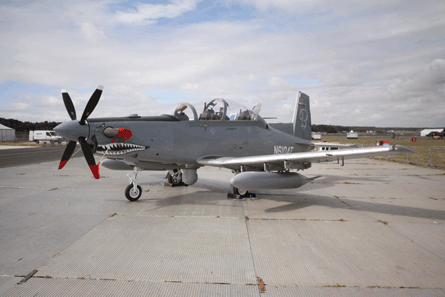What do you get when you cross a basic trainer with one of the world's most potent ground-attack aircraft? Hawker Beechcraft believes it has the answer, and today will fly in an AT-6 for the type's Farnborough debut.
Developed from the company's T-6B/C turboprop trainer by adding the Lockheed Martin mission system from the US Air Force's Fairchild A-10C "Warthog" upgrade, the AT-6 offers a low-cost option for the increasingly popular close air support and irregular warfare roles.
First flown one year ago, the first AT-6 testbed in April demonstrated its capabilities during the US Air Force's joint expeditionary force experiment. The aircraft flew nine sorties from Nellis AFB, Nevada, including operating in tandem with A-10s. A T-6C demonstrator made a further 15 flights in support of the Air National Guard-sponsored project.
 |
|---|
© Billypix |
The aircraft features numerous changes from the trainer variant, but "from a parts-count perspective they are 90-95% common, with the same logistics base", says Derek Hess, director of AT-6 programmes.
Key differences include a turret-housed L-3 Wescam MX-15Di electro-optical/infrared sensor and the addition of seven external stores stations. The light attack and armed reconnaissance aircraft also has a Cockpit 4000 avionics suite from Esterline CMC Electronics.
Upcoming flight tests will assess the use of precision-guided air-to-surface weapons, laser-guided rockets and countermeasures equipment, plus a colour helmet-mounted sighting system. It will also have its new 1,600shp (1,194kW) Pratt & Whitney Canada PT6A-68D engine installed within the next month, ahead of undergoing an operational utility evaluation "in the fall".
Hawker Beechcraft says it has already received significant interest in the AT-6 from a number of countries, including Afghanistan, Iraq, Lebanon and Thailand. Hess says an export configuration has already been released for "half a dozen of them".
A second demonstrator joined the flight test fleet on 31 March, and Hess says initial development work on the AT-6 will conclude within the next six to nine months.
"It's going better than anyone could have imagined," he says, but adds: "It's about integration, not invention."
- All the latest news, video and images from the 2010 Farnborough air show - New this year, live streaming video of each day's flying display
Source: Flight Daily News
















